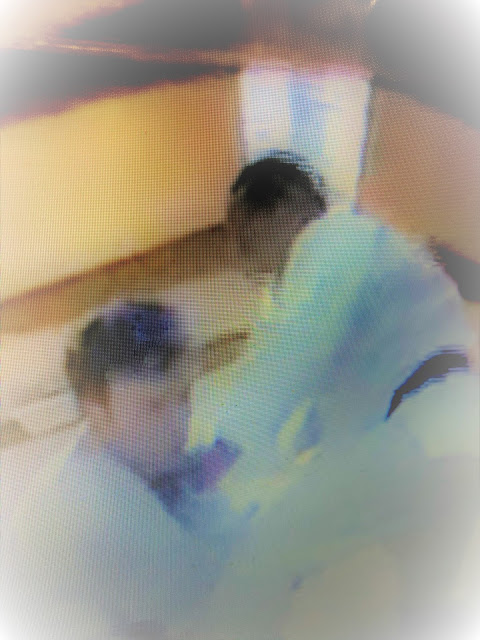脚戦
脚戦 (Kyakusen) is often spelt and pronounced incorrectly
by karateka who do not read or write Japanese. So I’d like to begin by helping
with this today. Firstly, a background… It seems many people get confused between
the names ‘Kyakusen’ and 鶴翼 ‘Kakuyoku’, which, are of course,
completely different kanji and have completely different meanings. Whilst Kakuyoku
means ‘Cranes wings’, Kyakusen translates as ‘Fighting with the legs’.
The correct pronunciation, for those
of you who know katakana, it's:
キャクセン (KYA-KU-SE-N).
This kata is also referred to as ‘Ashi-barai
no kata’; nevertheless, whilst ashi-barai is right through this formal
exercise, it certainly doesn’t sum it up—as there are just as many ‘ashi-ukewaza’ (leg receptions). A lot
of waza are directed diagonally (which is generically imperative for optimizing 'the line' when applying leg techniques) and the signature movements are the four ‘dropping’
sweeps in the last section.
There
were originally seven Kyakusen—Shodan to Nanadan, which makes them the longest
series of kata in 'Asai-style Shotokan'; however, Asai Tetsuhiko Sensei abbreviated them into what is now 乱雪 (Ransetsu), which is more commonly known
these days as 乱腿 (Rantai).
Kyakusen
(Shodan) has 45 movements with both kiai interestingly on hidari chudan
gyaku-zuki: movements 24 and 45 respectively. What is fascinating about this is
that Asai Sensei emphasized to preliminary actions/positions for these two
tsuki. The first was to come down from tateshuto-uke balanced on one leg. And
the second was to come up from the ground after the fourth final dropping sweep.
I must point out that Asai Sensei taught this sweep as a ‘ducking technique’
which, of course, was one of his specialties in jiyu-kumite.
Lastly,
before I briefly describe each movement in this kata, I want to say that it is
unique for me. This is because Kyakusen is one of the very few that Asai Sensei
himself never personally taught me. In this way, I feel it is a kata that I didn’t
properly learn; that being said, I have kept practicing it, as it has still been
beneficial for my ashiwaza. In this regard, I hope that this post will help you
benefit from it also. Osu, AB
MOVEMENT ONE: Turn 90 degrees
leftward, in migi ashi-dachi, with hidari uchi ashi-uke doji ni hidari shuto
uchimawashi uchi.
MOVEMENT TWO: Make migi
chudan gyaku-zuki whilst moving into hidari zenkutsu-dachi.
MOVEMENT THREE: Migi ashi-barai.
MOVEMENT FOUR: Advance with
hidari chudan gyaku-zuki into migi zenkutsu-dachi.
MOVEMENT FIVE: Turn 180 degrees
rightward, in hidari ashi-dachi, with migi uchi ashi-uke doji ni migi shuto
uchimawashi uchi.
MOVEMENT SIX: Make hidari
chudan gyaku-zuki whilst moving into migi zenkutsu-dachi.
MOVEMENT SEVEN: Hidari
ashi-barai.
MOVEMENT EIGHT: Advance with
migi chudan gyaku-zuki into hidari zenkutsu-dachi.
MOVEMENT NINE: Turn 270
degree with migi jodan haishu age-uke into migi zenkutsu-dachi.
MOVEMENT TEN: Migi ashi soto-uke,
hidari ashi-ashi, doji ni migi jodan sotonagashi-uke.
MOVEMENT 11: Migi naname
chudan mae-geri keage.
MOVEMENT 12: Punch hidari
chudan gyaku-zuki whilst transferring into migi zenkutsu-dachi.
MOVEMENT 13: dvance with
hidari jodan haishu age-uke into hidari zenkutsu-dachi.
MOVEMENT 14: Hidari ashi
soto-uke, migi ashi-dachi, doji ni hidari jodan sotonagashi-uke.
MOVEMENT 15: Hidari
naname chudan mae-geri keage.
MOVEMENT 16: Punch migi
chudan gyaku-zuki whilst transferring into hidari zenkutsu-dachi.
MOVEMENT 17: Make migi
hiza-uke, in hidari ashi-dachi, doji ni migi uraken uchimawashi uchi (diagonally
forward to the right).
MOVEMENT 18: Advance forward
on the angle to with hidari ashi-barai, migi ashi-dachi, doji ni hidari sho
nagashi-uke.
MOVEMENT 19: Hidari shuto
uchimawashi uchi into hidari zenkutsu-dachi.
MOVEMENT 20: Turn leftward
facing 45 degrees to the opposite side and make hidari hiza-uke, migi
ashi-dachi, doji ni hidari uraken yokomawashi uchi.
MOVEMENT 21: Advance forward
on the opposite angle with migi ashi-barai, hidari ashi-dachi, doji ni migi sho
nagashi-uke.
MOVEMENT 22: Migi shuto
uchimawashi uchi into migi zenkutsu-dachi.
MOVEMENT 23: Centralize
with migi ashi uchi-uke, hidari ashi-dachi, doji ni migi tateshuto-uke.
MOVEMENT 24: Step down
into migi zenkutsu-dachi with hidari chudan gyaku-zuki – KIAI!
MOVEMENT 25: Step back
diagonally with the left foot with migi ashi-barai, hidari ashi-dachi, doji ni
migi jodan sotonagashi uke.
MOVEMENT 26: Move into
migi zenkutsu-dachi with hidari gedan gyaku-zuki (target the myojo).
MOVEMENT 27: Step back
diagonally with the right foot with hidari ashi-barai, migi ashi-dachi, doji ni
hidari jodan sotonagashi uke.
MOVEMENT 28: Move into hidari
zenkutsu-dachi with migi gedan gyaku-zuki (target the myojo).
MOVEMENT 29: Step back onto
the centerline with the lead right foot into migi ashi-dachi doji with hidari
ashi-uke doji ni hidari tateshuto-uke.
MOVEMENT 30: Step back
naturally one more time but with the left leg into hidari ashi-dachi, with migi
ashi-uke doji uken jodan-zuki.
MOVEMENT 31: Step down
into migi zenkutsu-dachi with hidari chudan gyaku-zuki.
MOVEMENT 32: Turn 90
degrees leftward moving forward with the migi hiza-uke, hidari ashi-dachi, doji
ni migi tateshuto-uke.
MOVEMENT 33: Advance into
with hidari chudan gyaku-zuki into migi zenkutsu-dachi.
MOVEMENT 34: Drop into a
low migi ashi-dachi with hidari kyakusen no ashi-barai.
MOVEMENT 35: Punch migi
chudan gyaku-zuki whilst rising up and moving into hidari zenkutsu-dachi.
MOVEMENT 36: Turn 180
degrees clockwise and move forward with hidari hiza-uke, in migi ashi dachi,
doji ni hidari tateshuto-uke.
MOVEMENT 37: Advance punching
migi chudan gyaku-zuki whilst moving into hidari zenkutsu-dachi.
MOVEMENT 38: Drop into a
low hidari ashi-dachi with migi kyakusen no ashi-barai.
MOVEMENT 39: Punch hidari
chudan gyaku-zuki whilst rising up and moving into migi zenkutsu-dachi.
MOVEMENT 40: Turn 90 degrees
rightward (facing ura-shomen) and block with migi ashi uchi-uke, in hidari ashi-dachi,
doji ni migi shuto uchimawashi-uchi.
MOVEMENT 41: Naturally
step down and slight forward with the right foot then make hidari kyakusen no ashi-barai.
MOVEMENT 42: Punch migi
chudan gyaku-zuki whilst rising up and moving into hidari zenkutsu-dachi.
MOVEMENT 43: Turn leftward/anticlockwise
180 degrees with hidari ashi uchi-uke, in migi ashi-dachi, doji ni hidari shuto
uchimawashi uke.
MOVEMENT 44: Drop into a
low hidari ashi-dachi with migi kyakusen no ashi-barai.
MOVEMENT 45: Punch hidari
chudan gyaku-zuki whilst rising up and moving into migi zenkutsu-dachi – KIAI!
© André Bertel. Oita City, Japan (2021).




